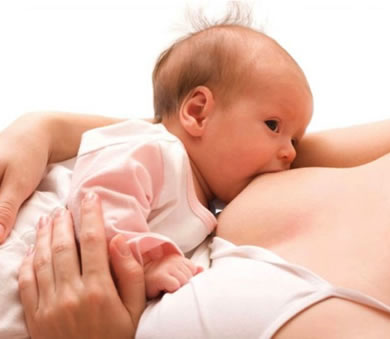 Conventional wisdom, supported by scientific research, advocates breastfeeding as the superior method of infant feeding.
Conventional wisdom, supported by scientific research, advocates breastfeeding as the superior method of infant feeding.
Unfortunately, in some case, breastfeeding can become a challenge for both child and mum.
Events such as forceps or ventouse delivery, traumatic birth, intrauterine pressure etc. can create abnormal tension in the newborn body that can affect the ability of the child to properly latch on and or swallow.
Osteopathic treatment can help to resolve abnormal and undue tensions that impede the action of sucking/swallowing.
In this post, I will focus on some aspect of the nutritional and immunological benefits of breastfeeding; in another post I will discuss the importance of breastfeeding for the development of the cranial structures.
The initial urge to suck in a newborn has a twofold effects:
- To stimulate milk production in the mother
- The ingestion of the colostrum that helps to mature and protect the gastrointestinal tract of the newborn and it is the most potent and natural immune booster known.
Colostrum it’s very high in immunoglobulins IgA (an antibody that play a vital role in the immune function in the mucus membranes) but also IgG ( Main antibody found in blood allowing it to control infection in body’s tissues) lactoferrin, leukocytes and developmental factors. Indicating that its primary function it’s immunologic.
Although we typically think of the gastro intestinal tract as place where food is digested and then discarded, it is also an immunological powerhouse that contains more than 80% of all immune cells!
In utero, our digestive tracts are sterile. We haven’t eaten anything yet.
As your baby travels down the birth canal, she/he will swallow the beneficial bacteria that live there. Those bacteria will then colonize your child gut and begin to establish her/his gut microbiome.
The microbiome is the balance of the microorganisms, such as the good and the bad bacteria, parasites, and fungi, that live in the gut.
The gut is the gateway to good health, and good health is synonymous with a healthy microbiome.
Following this first exposure to vaginal bacteria, the immune system of the baby is further strengthen by the colostrums as seen above and the maternal milk that contains several compounds that have immune- modulating capacities as well as nutritional elements that are necessary to the developmental needs of the newborn.
The healing properties of the colostrum have been known for centuries! In Ajurvedic healing it was used to treat infection and more recently it has been used in adults to promote gut healing and provide passive immunity protection in patients with compromised gastro intestinal function such as Chron, leaky gut etc.
The milk composition is dynamic and varies within feeding, diurnally, over lactation and between mothers. It changes to adapt to the infant needs regarding immune protection and nutrition.
Besides micro and macronutrient and immunological factors, the maternal milk contain numerous growth factors that have a wide ranging effect on the intestinal tract, vasculature, nervous system and endocrine system of the newborn.
Here below some of the benefits of the maternal milk:
- Mother’s milk provides the baby’s intestinal tract with friendly bacteria that protect the newborn gastrointestinal tract. Breastfeeding modify the gut microbiome by enriching bacteria in the gut that are positively associated with so the called Regulatory T cell. These are cells that keep the immune system in check and prevent the development of autoimmune diseases such as allergy and asthma.
- Children fed on breast milk have higher level of Leptin, an hormone that regulate appetite and fat storage
- Researches have suggested that breast bilk promote development of brain white mater
- Breast milk provides protective antibodies to the newborn. It protects against infections such as otitis media, urinary tract infection, respiratory tract infection. Etc.
- It enhances cognitive and visual development and reduce pain in infant
- When the mother is exposed to virus or bacteria, she starts producing antibodies that are secreted into the breast milk and passed to the baby during feeding. This is why, according to some, breastfeeding mum with the flu may actually provide their baby with antibody that help them fight the pathogen that is causing the sickness.
- Mother’s milk contains high anti-inflammatory compounds.
Tips for increasing breast milk production:
- Have close contact with your baby. Skin-to-skin contact with your baby, especially within the first hour of delivery, can stimulate breast milk production. Sometimes it can be harder to breastfeed when you have had a C-section, so in that case it is especially important to get lots of physical contact with your newborn.
- Begin breastfeeding as soon as possible.
- Hydrate. Breast milk contains a high percentage of water and lots of water-soluble vitamins. Your water requirements will increase while breastfeeding.
- Eat non gluten-containing grains (if you can tolerate them). In many women, grains can stimulate milk flow. Only eat them if you don’t have sensitivity to grains.
- Eat a clean, nutrient-dense diet full of organic fruits, vegetables, and pasture-raised and grass fed animal protein. Everything your baby eats in the first year of life comes from what you put into your own body. You need to make sure you’re getting the vitamins and minerals you both need!
REFERENCES
- Newman J. (1995) How breast milk protects newborns. Scientific Amer; 273:58-61.
- Goldman A, Goldblum R, Hanson, L. (1991) Anti-inflammatory systems in human milk. Adv Exp Med Biol; 262:69-76.
- R.D. Stevenson, JH Allaire (1991) The development of normal feeding and swallowing. Paediatric of north america. 38 (6) 1439
- MJohnson, S. Landers (2012) Breastfeeding and the use of human milk. Paediatrics 129 (3)
- Palmeira P, Carneiro sampaio M (1992) Immunology of breast milk. Rev Assoc Med Bras 62 (6)
- Zembo C. (2002) Breastfeeding. Obstet Gynecol Clin North Am. 29(1)
- Hanson LA, Silfverdal SA, Stromback L. (2001) The immunological role of breastfeeding. Paediatr Allergy Immunolo 12(14)
- Noverr Mc, Huffnagle (2005) The microflora hypothesis of allercic disease. Clin Exp Allergy 35(12)
- Schlaundecker EP, Steinhoff MC, Omer SB (2013) IgA and the neutralising anibodies to influenza a virus in human milk: a randomised trial of antenatal influenza immunization. PLoS Online 14 8 (8)
- Hanson LA (1998) Breastfeeding provides a passive and likely long lasting active immunity . Ann Allergy Asthma Immunol. 8 (16)
 Receive for free the e-book I have specifically written for you, to help you learn more about the uniqueness and preciousness of your body and start a new journey of greater health and happiness. Your email is not shared with third parties and stored a GDPR compliant service provider (AWeber).
Receive for free the e-book I have specifically written for you, to help you learn more about the uniqueness and preciousness of your body and start a new journey of greater health and happiness. Your email is not shared with third parties and stored a GDPR compliant service provider (AWeber).